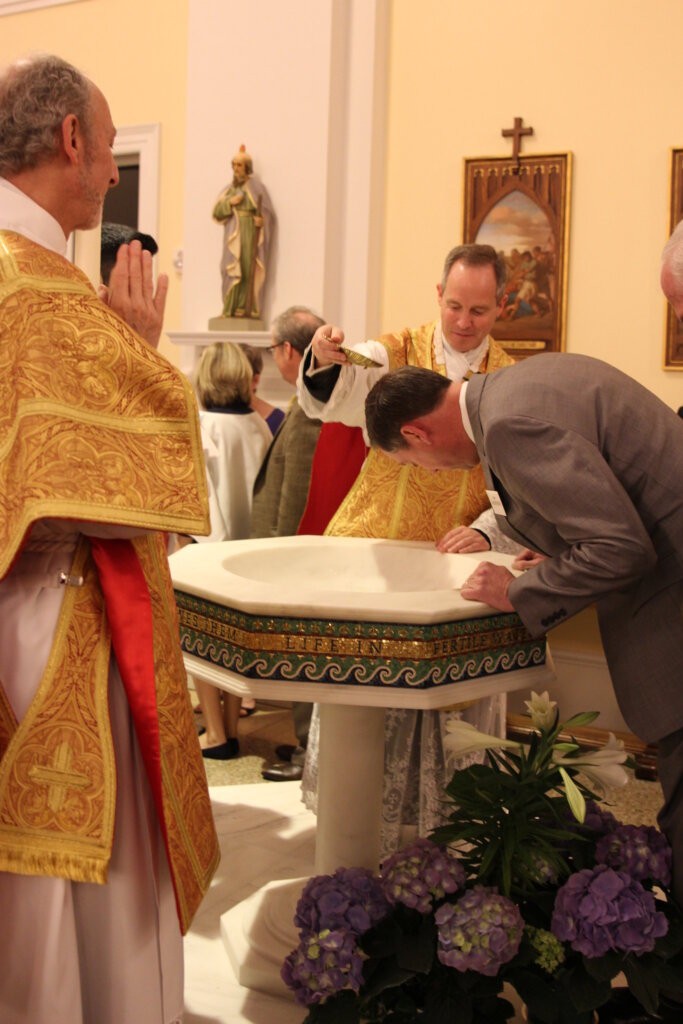When Jesus journeyed to the Jordan River to be baptized, John the Baptist, his cousin, recognized the profound incongruity of the request. John understood Jesus’ divine nature and sinless perfection, exclaiming in Matthew 3:14, “I need to be baptized by you, and do you come to me?” This interaction highlights a central question for Christians: Why, if baptism is for the remission of sins, would Jesus, the Son of God, seek baptism?
Jesus responded to John’s astonishment with the enigmatic statement, “Let it be so now; for thus it is fitting for us to fulfill all righteousness” (Matthew 3:15). This declaration, “to fulfill all righteousness,” offers a critical clue. But to fully grasp the significance of Jesus’ baptism, we must delve deeper into the meaning of baptism itself and explore the multifaceted reasons behind Christ’s seemingly paradoxical act.
Understanding Baptism: A Foundation
Before we explore why Jesus underwent baptism, it’s crucial to revisit the fundamental understanding of baptism, especially within a Christian context.
Baptism is a sacrament of spiritual rebirth through water and the Word of God. Traditionally understood as a rite of initiation and purification, baptism signifies:
The Sacrament of regeneration by water in the word. By nature we are born from Adam children of wrath, but by Baptism we are regenerated in Christ, children of mercy. For He gave power to men to be made the sons of God, to them that believe in his name, who are born, not of blood, nor of the will of the flesh, nor of the will of man, but of God.
The Catechism of Trent
The Catechism of the Catholic Church further elucidates baptism’s role in uniting believers with Christ:
Baptism is the first and chief sacrament of forgiveness of sins because it unites us with Christ, who died for our sins and rose for our justification, so that “we too might walk in newness of life.”
The Catechism of the Catholic Church (977)
Considering these definitions, it becomes even more apparent that Jesus, being inherently sinless and divine, did not require baptism for personal purification or spiritual regeneration. His baptism was distinct from the baptism meant for humanity. However, every action of Jesus held profound purpose. His baptism, though not for his own need, was laden with significance. Theologians, Church Fathers, and Popes have illuminated several key reasons why Jesus chose to be baptized by John.
1. Identification with Sinners: Jesus Takes on Humanity’s Burden
The real novelty is the fact that he—Jesus—wants to be baptized, that he blends into the gray mass of sinners waiting on the banks of the Jordan.
Pope Benedict XVI, Jesus of Nazareth
One of the most profound reasons for Jesus’ baptism is his deliberate act of solidarity with humanity, particularly with sinners. Jesus, fully God yet fully man, embraced human experience in its entirety, except for sin (Hebrews 4:15). His willingness to be baptized alongside those confessing their sins at the Jordan River was a powerful demonstration of humility and identification.
Pope Benedict XVI eloquently describes this act:
Jesus loaded the burden of all mankind’s guilt upon his shoulders; he bore it down into the depths of the Jordan. He inaugurated his public activity by stepping into the place of sinners. His inaugural gesture is an anticipation of the Cross.
Pope Benedict XVI, Jesus of Nazareth
By immersing himself in the waters of baptism, Jesus symbolically took upon himself the sins of humanity, prefiguring his ultimate sacrifice on the cross. He positioned himself among those seeking repentance, even though he himself was without sin. This act underscores his mission to redeem humanity from sin and its consequences. As Isaiah 53:5 prophesied:
…he was wounded for our transgressions, he was bruised for our iniquities; upon him was the chastisement that made us whole, and with his stripes we are healed.
Jesus, though innocent, willingly experienced the symbolic cleansing meant for sinners, demonstrating his profound empathy and commitment to humanity’s salvation. His presence among the penitent at the Jordan River was a visual representation of his willingness to stand in our place.
2. Sanctifying the Waters: Empowering Baptism for Future Believers
Another significant reason, emphasized by Church Fathers and theologians, is that Jesus’ baptism served to sanctify the very waters used in baptism for all subsequent believers. By entering the waters of the Jordan, Jesus imbued them with a purifying and sanctifying power.
The Council of Trent explains this concept:
[Baptism] was instituted by our Lord when, having been baptized by John, He gave to water the power of sanctifying… [W]hen our Lord was baptized, water, by contact with His most holy and pure body, was consecrated to the salutary use of Baptism…
Catechism of the Council of Trent
This idea is further echoed by early Church Fathers:
The Lord is baptized, not because He had need to be cleansed, but in order that, by the contact of His pure flesh, He might purify the waters and impart to them the power of cleansing.
St. Augustine
Our Lord was baptized because He wished, not to be cleansed, but to cleanse the waters, that, being purified by the flesh of Christ that knew no sin, they might have the virtue of baptism.
St. Ambrose (as quoted by St. Thomas Aquinas in his Summa Theologica)
“[Jesus was baptized ]that He might bequeath the sanctified waters to those who were to be baptized afterwards.”
St. John Chrysostom (as quoted by St. Thomas Aquinas in his Summa Theologica)
Through his immersion, Jesus transformed ordinary water into a conduit of grace, capable of cleansing sins and initiating new life in Christ. His baptism was not merely a personal act but a cosmic event that imbued the element of water with salvific power for generations to come.
3. Symbolism of Death and Resurrection: Foretelling the Paschal Mystery
The Baptism of Christ by Michiel Sweerts (1656-1659)
Jesus’ baptism also carries profound symbolic weight, prefiguring his death and resurrection – the Paschal Mystery at the heart of Christian faith. The act of immersion in water symbolizes death and burial, while rising from the water represents resurrection and new life.
Pope Benedict XVI elucidates this symbolism:
On one hand, immersion into the waters is a symbol of death, recalling the death and destruction of the flood. On the other hand, the flowing waters of the river Jordan are also, and above all, a symbol of life.
Jesus himself alluded to this connection between baptism and his impending suffering when he spoke of a “baptism” he was yet to undergo:
“Are you able to drink the cup that I drink, or to be baptized with the baptism with which I am baptized?”
Mark 10:38
“I have a baptism to be baptized with; and how I am constrained until it is accomplished!”
Luke 12:50
In these passages, “baptism” is used metaphorically to represent his suffering and death. Pope Benedict XVI connects these threads, explaining:
The baptism is an acceptance of death for the sins of humanity, and the voice that calls out “This is my beloved Son” over the baptismal waters is an anticipatory reference to the Resurrection. This also explains why, in his own discourses, Jesus uses the word “baptism” to refer to his death.
Pope Benedict XVI, Jesus of Nazareth
Therefore, Jesus’ baptism at the Jordan River was not just an isolated event but a symbolic foreshadowing of his ultimate sacrifice and triumph over death. It was a prophetic enactment of the Paschal Mystery, the core of Christian redemption. The imagery of the Lamb of God, often associated with Jesus, further reinforces this connection to sacrifice and redemption, as highlighted in the Gospels’ accounts of the baptism.
4. Inauguration of His Messianic Mission: Anointing and Divine Approval
Finally, Jesus’ baptism marked the official commencement of his public ministry and messianic mission. The descent of the Holy Spirit upon him immediately following his baptism, accompanied by the voice of God the Father declaring, “This is my beloved Son, with whom I am well pleased,” served as a divine anointing and commissioning.
Pope Benedict XVI explains this aspect:
The descent of the Holy Spirit upon Jesus, which concludes the baptismal scene, is to be understood as a kind of formal investiture with the messianic office. The Fathers of the Church therefore rightly saw this event as analogous to the anointing by which kings and priests in Israel were installed in office. The words Christ and Messiah mean “the Anointed”: In the Old Testament, anointing was regarded as the visible sign that the person anointed was being invested with the gifts of office, with the Spirit of God…
This anointing by the Holy Spirit empowered Jesus for his earthly ministry. As Luke 4:18 recounts, Jesus himself referenced Isaiah to describe his mission:
“The Spirit of the Lord is upon me, for he has anointed me to proclaim good news to the poor. He has sent me to proclaim liberty to the captives and recovering of sight to the blind, to set at liberty those who are oppressed…”
Following his baptism and anointing, Jesus embarked on his mission to preach, heal, and ultimately redeem humanity. His descent into the waters was, in a sense, a descent into the world and its struggles, a necessary step before he could begin his work of lifting up fallen humanity.
Conclusion: The Multifaceted Significance of Jesus’ Baptism
Baptism of Christ (1895) by José Ferraz de Almeida Júnior
In conclusion, the baptism of Jesus, though seemingly paradoxical for the sinless Son of God, is rich in theological significance. It was not an act of personal purification but a deliberate and purposeful event with profound implications for humanity.
Jesus’ baptism served to:
- Identify him with sinners, demonstrating his solidarity with humanity and his willingness to bear the burden of sin.
- Sanctify the waters of baptism, transforming them into a means of grace for future believers.
- Symbolize his death and resurrection, foreshadowing the Paschal Mystery and the core of Christian redemption.
- Inaugurate his messianic mission, marking the beginning of his public ministry with divine anointing and approval.
Through his baptism and subsequent Paschal sacrifice, Jesus liberated humanity from the bondage of sin and restored our lost dignity as children of God. As the Catechism of the Catholic Church (537) beautifully states:
Everything that happened to Christ lets us know that, after the bath of water, the Holy Spirit swoops down upon us from high heaven and that, adopted by the Father’s voice, we become sons of God.
Through understanding Jesus’ baptism, we gain deeper insight into his mission, his love for humanity, and the transformative power of Christian baptism itself.
Reflect on these reasons: What aspect of Jesus’ baptism resonates most deeply with you and why?
Are there other events in Jesus’ life or the Bible that you find puzzling or wish to explore further?
Share your reflections and questions in the comments below.
To deepen your understanding of Jesus’ life, explore resources like “The Life of Christ,” which can offer further insights into his actions, teachings, and the profound meaning behind them.

